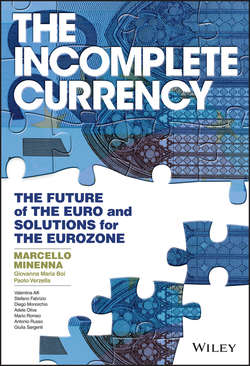Читать книгу The Incomplete Currency - Marcello Minenna - Страница 15
На сайте Литреса книга снята с продажи.
Chapter 1
The Building Blocks of the Single European Currency
1.1 The Basic Concepts: Financial Flows, Risks and Probability Distribution
1.1.2 Swap Rate of a Floating Rate Bond
ОглавлениеA floating rate bond like the one described in Figure 1.4 has uncertain results by definition, given that it is not possible to know beforehand the actual return that the investor will get; conversely, a bond at a fixed rate, such as a government bond, pays the same coupon regardless of changing market conditions. At a first reading, the two investments are therefore not comparable. However, the professional financial operators still have the need to compare the fixed rate with the floating rate transactions, and they do so by calculating a fixed rate that is representative of the operation at a variable rate: the swap rate. Let's try to understand this further.
Let's reconsider the 2-year floating rate bond issued by Bank A in Figure 1.4. The fair price of this bond is now 100. Now let's try to answer this question: given a fixed coupon bond with the same number of bond coupons from Bank A (four), which fixed interest rate should I pay to have a fair price equal to 100, that is, the same as our floating-rate bond?
Imagine being able to calculate this fixed rate and obtain a value equal to 1.4 %. Through this indicator we are saying that the holder of the floating rate bond will get on average the same return as the holder of a bond with an annual fixed coupon rate of 1.4 %; the bonds are different and will yield differently, but for professionals the two bonds are considered equivalent (always on average) for the purposes of comparison, so much so that they have the same value. In the first panel in Figure 1.5, the horizontal line represents the (fixed) swap rate in comparison to the possible developments of the floating rate. In the second panel, the fixed coupon corresponding to the swap rate is represented by the horizontal line.
Figure 1.5 Calculation of the swap rate of a 2-year floating-rate bond issued by Bank A
Let's take a last example and consider government bonds: if I have a CCT (the standard Italian floating-rate bond) and a BTP (the standard fixed rate bond) sharing the same maturity, and the bonds have the same fair price, the interest rate paid by the BTP will be the swap rate of the CCT.
Swap rates are very helpful for professionals because they can condense into one number for each contractual maturity (the so-called interest rate curve) all information relating also to floating interest rates. For now we have considered just one issuer at time (Bank A or the Italian Republic). Let's try to complicate things for a minute: consider a set of other banks belonging to the same banking system, like the European one (Eurosystem); by averaging the swap rates of every issuer, it is possible to get an image of the state of the banking system as a whole through the publication of a single interest rate curve.
We will return to this argument when it is time to analyse the functioning of the European banking system.
